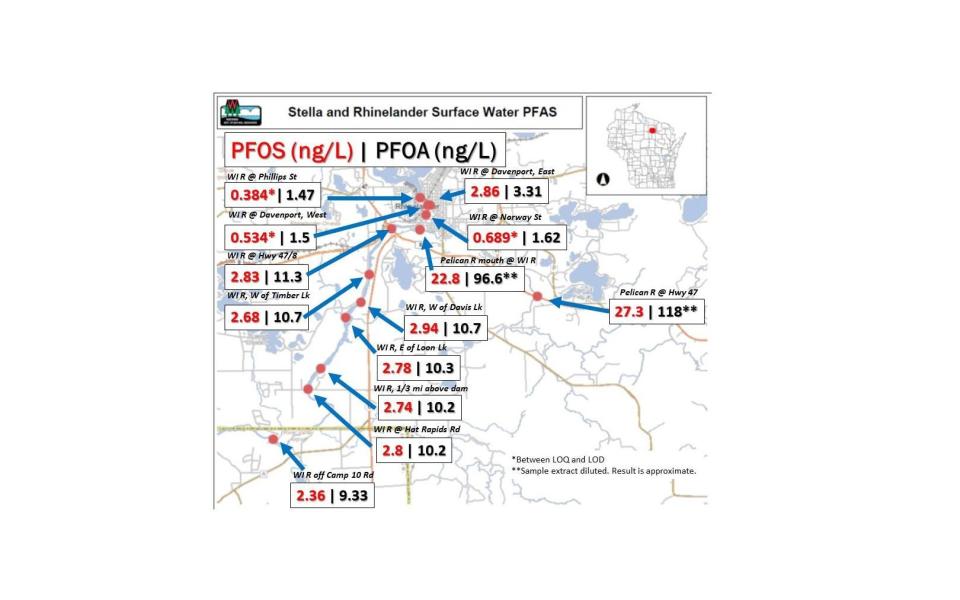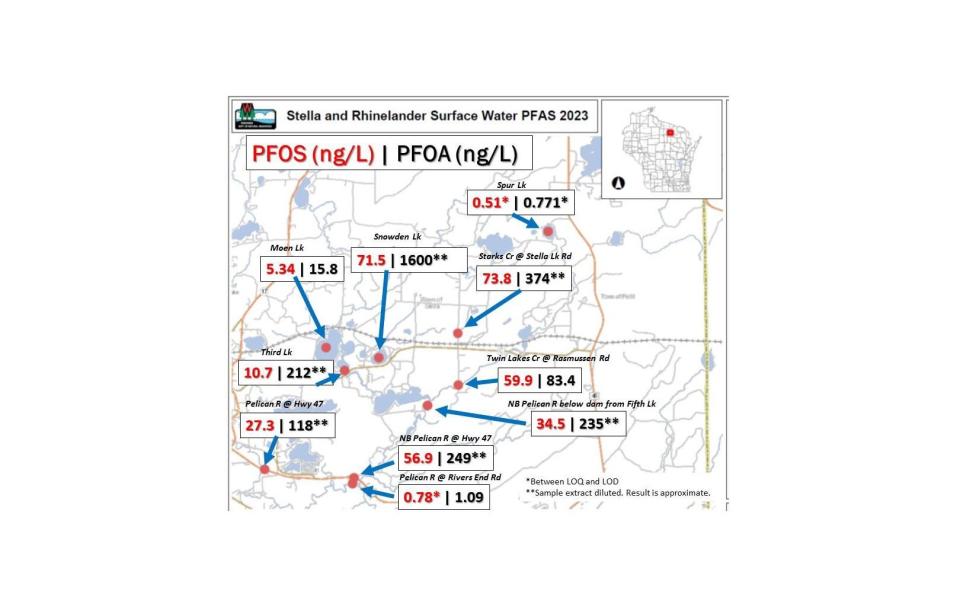'Forever chemicals' found in Wisconsin River, lakes near Stella, raising concerns over fish
Tom LaDue has been eating the fish he caught out of Snowden Lake for years without a concern, but now, he's starting to wonder if those fish could be harmful to his health after high levels of "forever chemicals" were found in the water.
"You hate to think you're eating something that's tainted, but I've been fishing Snowden Lake for years," he said. "So I don't know if it makes any difference to stop immediately or not."
Snowden Lake is one of several bodies of water located near the Oneida County community of Stella, where some of the highest levels of PFAS have been found in the private wells of dozens of residents. Finding out the water they used for drinking, cooking and bathing was a blow to the community already, but now knowing that fishing could be unsafe is another blow.
"It's shocking," LaDue said. "We don't know where we're going to go with this."

Well water in Stella has tested as high as 36,000 parts per trillion of PFAS, dwarfing the federally recommended standard of 4 parts per trillion and the state standard of 70 parts per trillion. The numbers are likely some of the highest in the country.
So far, the Department of Natural Resources has sampled 114 private wells in Stella, which is about 10 miles east of Rhinelander. Of those 49 had levels of PFAS above the state limits, 32 had detections below limits and 33 had no detection. According to DNR information, 47 health advisory letters have been sent out, making those homeowners eligible for free bottled water.
The DNR also started to look at the surface water in the area, testing in dozens of places, including the Pelican River, the Wisconsin River and many of the small lakes near Stella.
It's likely the surface water contamination stems from the groundwater in the area, said Patrick Gorski, an emerging contaminants research scientist with the DNR.
"Groundwater tends to flow into surface water, so we do believe that they are connected," he said.
The agency is still working to find just how widespread the contamination is in both the groundwater and surface waters, but sampling is underway to try and get an idea.
So far, some of the highest concentrations of PFOS and PFOA — two of the most well-known and well-researched PFAS compounds — have been found in the Pelican River, Snowden Lake, Starks Creek, Twin Lakes Creek and Third Lake. Some of the concentrations go as high as 1,600 parts per trillion.
As for the Wisconsin River, levels as high as 10 parts per trillion were detected, which is below the state standard of 70 parts per trillion, but above the federal recommendation of 4 parts per trillion.
Though the state does not have groundwater standards for PFAS, there are surface water standards of 95 parts per trillion for PFOA and 8 parts per trillion for PFOS for bodies of water not used as drinking water supplies.
Dave Hansen immediately stopped eating the fish he harvested from the Stella area this summer, as soon as the state indicated there could be an issue.
He lives on Fifth Lake, one in a chain of lakes found to be impacted by the PFAS contamination.
"I'm sure these fish have been in this lake for years, so who knows how long these fish have actually been exposed to this, and what levels they're at," he said. "I certainly do have concerns."
The DNR is working to analyze the level of PFAS in fish harvested from lakes around Stella, which will help to give a better idea of the risk that could be associated with consumption.
If fish are impacted, the state will release a consumption advisory warning anglers not to consume too much fish, Gorski said.

Possible impact on North Woods tourism
The emergence of PFAS in surface water also raises concerns for tourism as the Rhinelander area is a magnet for visitors who fish the popular lakes and streams in the area. Cabins and summer camps also sit near some of the contaminated waters.
Bill Sherer, the owner of We Tie It Fly Shop in Boulder Junction, said people might hesitate to fish in lakes near Stella if they hear of contaminated fish.
"It does concern me that people may run into health problems or shorten their lives," he said.
It's a huge concern for Sherer that PFAS are being found in more bodies of water across the state, and he's worried that other waters could be over-fished because of it.
"These are problems and concerns that every Wisconsin citizen should be worried about," he said.
More: Residents in a Wisconsin town with extreme PFAS contamination file lawsuit against paper mill
About PFAS
PFAS, or per- and polyfluoroalkyl substances, are a family of man-made chemicals used for their water- and stain-resistant qualities in products like clothing and carpet, nonstick cookware, packaging and firefighting foam.
The family includes 5,000 compounds, which are persistent, remaining both in the environment and human body over time. The chemicals have been linked to types of kidney and testicular cancers, lower birth weights, harm to immune and reproductive systems, altered hormone regulation and altered thyroid hormones.
The chemicals enter the human body largely through drinking water. PFAS have been found across Wisconsin.
Laura Schulte can be reached at leschulte@jrn.com and on Twitter at @SchulteLaura.
THANK YOU: Subscribers' support makes this work possible. Help us share the knowledge by buying a gift subscription.
DOWNLOAD THE APP: Get the latest news, sports and more
This article originally appeared on Milwaukee Journal Sentinel: PFAS found in Wisconsin River, several lakes near Stella

